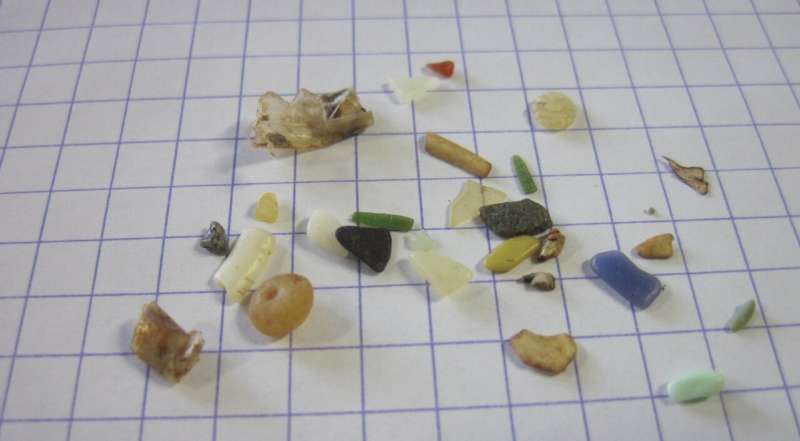Plastics found in a single seabird's body. Grid: 5 mm × 5 mm. Credit: Hideshige Takada, TUAT
An international collaboration led by scientists at Tokyo University of Agriculture and Technology (TUAT) , Japan, has found that hazardous chemicals were detected in plastics eaten by seabirds. This suggests that the seabird has been threatened by these chemicals once they eat plastics.
The research findings were published in Marine Pollution Bulletin in May 2019.
The researchers carried out non-target survey of additives in 194 pieces of plastics ingested by seabirds, such as Northern Fulmar and Albatross. These additives, which are often hazardous chemicals, are generally blended into most plastics in order to make plastics better, for instance to stabilize polymers against UV degradation or oxidation, to simply add colors, and so on.
"We uncovered that four kinds of UV stabilizers and two brominated flame retardants at detection frequencies of 4.6 percent and 2.1 percent, respectively," said Dr. Hideshige Takada, the corresponding author and professor in the Laboratory of Organic Geochemistry of TUAT. "Our previous research showed that these additives in plastics are transferred from ingested plastics and unfortunately accumulated in some tissues of seabirds."
"These findings imply that any of these additives can be detected in the tissue of seabirds which ingest 15 pieces of plastics with probability of 73 percent. We found that ingestion of 15 pieces of plastics per one individual is actually happening in the real-world case of the Albatross," said Dr. Takada. "We could foresee in the near future that 90 percent of the individuals would accumulate additives derived from ingested plastics if the number would increase double, that is 30 pieces per individual."
More information: Kosuke Tanaka et al, Piece-by-piece analysis of additives and manufacturing byproducts in plastics ingested by seabirds: Implication for risk of exposure to seabirds, Marine Pollution Bulletin (2019). DOI: 10.1016/j.marpolbul.2019.05.028
Journal information: Marine Pollution Bulletin
Provided by Tokyo University of Agriculture and Technology
























